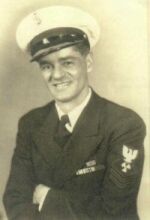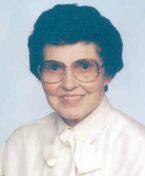USS SLC..."Enlisted Navy"...Theodore "Ted" R. Swenson, CMM
 Ted passed away on Feb. 27th, 2013. Information from son, Steve Swenson.
Ted passed away on Feb. 27th, 2013. Information from son, Steve Swenson.
2000
Hello Sandy,
At present I am serving as treasurer for Pat Monteleone during his tour as President
of the USS Salt Lake City Association.(2000-2001) He tells me that you may
join us at the next reunion. We look forward to meeting you and the family.
I think that you are doing a tremendous job of putting the USS Salt Lake
City (CA-25) on the internet. Your Dad would be very proud of what you
have accomplished.
Ted Swenson
Feb. 18th, 2000
Sandy
With much help from my wife, here is my picture and a short history of my
tour aboard the USS Salt Lake City.
I enlisted in the US Navy on Feb. 11, 1938, at Kansas City, MO. and was
sent to San Diego Naval Training Center. After completing recruit training
I boarded the USS Richmond for transportation to Norfolk, VA., for
Machinist School. Graduated from school in November and reported aboard
the USS Salt Lake City at Long Beach, CA. just a few days before Christmas,
1938. The first duty assignment was to "B" Division #3 fireroom. In
March, I was transferred to "A" division with duties in the Machine Shop
and Boat Shop as Boat Engineer.
In July I was assigned "Mess Cook" duties for the "A" Division. Prior to
Dec., 1940, food was served "family style". Each mess cook took care of
20 men at two tables for his division. The tables and benches were stored
in the overhead above the spot where the men were served. Food was brought
down from the galley in tureens by the mess cook. As a mess cook, you
could and did make extra money by taking good care of the men at his
tables. The crew was paid monthly and good mess cook could make as much
as $15.00 in tips. One must remember that the mess cook's pay was only
$36.00 per month.
We had to take care of our own tables, benches, plates and silverware. If
you dropped a plate and it broke, the cost of replacement came our of your
pay. Every Friday was "Field day" in preparation for Captain's inspection
on Saturday. Mess cooks had to have their tables all set up with plates
and silverware. The "B1" tables were adjacent to "A" division tables.
If I recall correctly the B1 mess cook was

 Oren T. "Red" Woodford. All I
remember for sure was that everyone called him
"Red. He and I worked together as a
team in getting ready for inspection. After the first couple of
inspections we had figured out what the inspecting officer was looking for
to make his selection of #1 and #2 best tables. All of us had an
assortment of new and old plates and silverware. "Red" and I traded plates
and silverware so that he could have one table with all new plates and
shiny silverware (he had more new plates than I did is the reason he got
the additional new ones). The rest of the table settings were carefully
arranged from the shiniest at one end to the dullest at the far end. This
was like lining up your men for inspection with the tallest at the
beginning and the shortest at the far end. After that "Red" and I place
first and second nearly every week. There was monetary reward for this
from the "Welfare and Recreation Fund" of $2 and $1 each week.
Oren T. "Red" Woodford. All I
remember for sure was that everyone called him
"Red. He and I worked together as a
team in getting ready for inspection. After the first couple of
inspections we had figured out what the inspecting officer was looking for
to make his selection of #1 and #2 best tables. All of us had an
assortment of new and old plates and silverware. "Red" and I traded plates
and silverware so that he could have one table with all new plates and
shiny silverware (he had more new plates than I did is the reason he got
the additional new ones). The rest of the table settings were carefully
arranged from the shiniest at one end to the dullest at the far end. This
was like lining up your men for inspection with the tallest at the
beginning and the shortest at the far end. After that "Red" and I place
first and second nearly every week. There was monetary reward for this
from the "Welfare and Recreation Fund" of $2 and $1 each week.
The general area of where your division ate was also the berthing area.
Large storage bins lined the outside edge of the compartment to store
hammocks, cots and bedding. There was space for about twelve cots in the
"A" division area, the rest had to sleep in hammocks. In stormy weather
the hammocks were the best place to be to sleep.
In September, 1939, a big storm hit southern CA., and the ship had to go
to sea to ride out the storm. Over half of the crew was ashore on liberty
along with motor launches and motor boats and crews. The mess cooks fed
the crew on watch as they were on four hours and off four. Sandwiches and
coffee were the menu of the day.
In October, a new group took over mess cooking duties, and we were returned
to our prior assignments. My duties were as boat engineer of #2 Motor
Launch and as messenger in the after engine room when the ship was
underway. The ship spent the next thirteen months operating out of Pearl
Harbor. In December, 1940, the ship entered Mare Island Naval Shipyard
for extensive modifications to the living areas. After that the men were
fed cafeteria style and bunks were installed. Diesel powered boats were
brought on board. The emergency power system of storage batteries was
replaced by diesel powered generators. One of the bunker fuel oil tanks
was converted to store diesel fuel. It is my understanding that when the
salt water contaminated fuel put out the fires under all the boilers during
the Komandorski battle, diesel oil fuel was used to light the fires under
the boilers. The ship would not have been able to recover so quickly
without that availability of diesel fuel oil.
With diesel powered boats on board, I was no longer considered qualified
as boat engineer. My new duty assignment included steam heating system,
refrigeration, anchor windlass, steering gear maintenance and standing
underway watches in after engine room. During the summer of 1943 I was
promoted to Chief Machinist Mate and in charge of "A" Division.
During the period of bombardment at Tarawa the port hydraulic "A" steering
unit jammed and steering power was shifted to the starboard unit.

 LCDR John Lambert, the Engineering Officer,
stated that the Captain wanted to remain with the task force if we could
make the necessary repairs underway. I assured him that we could, but
would need a minimum of six chain falls to hoist the unit and keep it from
swinging and sliding around or damaging the other piping and machinery.
Mr. Lambert said I could have all the chain falls that we needed. It took
B. C. Allgood, MM1c and I three weeks to get
the job done as we stood our regular
watches and worked during our off watch time. Mr. Lambert came down while
we were assembling the repaired parts and stamped the date repairs were
made on the parts using metal stamping tools.
LCDR John Lambert, the Engineering Officer,
stated that the Captain wanted to remain with the task force if we could
make the necessary repairs underway. I assured him that we could, but
would need a minimum of six chain falls to hoist the unit and keep it from
swinging and sliding around or damaging the other piping and machinery.
Mr. Lambert said I could have all the chain falls that we needed. It took
B. C. Allgood, MM1c and I three weeks to get
the job done as we stood our regular
watches and worked during our off watch time. Mr. Lambert came down while
we were assembling the repaired parts and stamped the date repairs were
made on the parts using metal stamping tools.
In April, 1944, orders came for my transfer back to the USA to be
commissioned as Ensign. The next time I saw the USS Salt Lake City was in
Okinawa as she lay at anchor and providing fire support for the ground
troops. I was engineering officer on the USS LCS (L) 123.
In November, 1962, I retired from active duty. My last duty station was
at the Navy and Marine Corps Reserve Training Center at Danville, IL.
One thing I missed having in the modern Navy was the "family style" of
feeding the crew as one got to see and talk to the other members of the
division at meal time each day. This led to getting to know each other
better and encouraged greater camaraderie.
Theodore "Ted" Swenson
SLC Deck Logs Mar. 1943
Dec. 1943
Apr. 1944
#22 in "A" Division, 1944
|


 Ted passed away on Feb. 27th, 2013. Information from son, Steve Swenson.
Ted passed away on Feb. 27th, 2013. Information from son, Steve Swenson.
